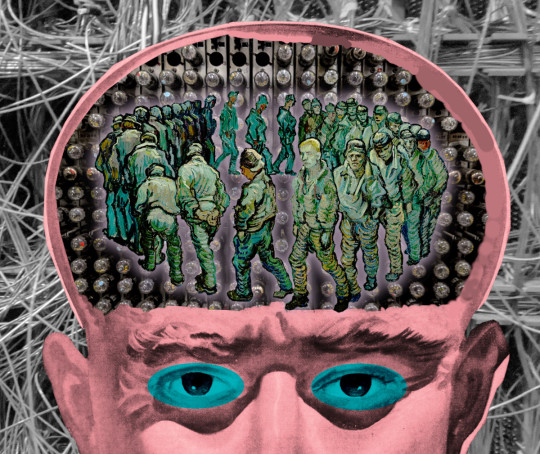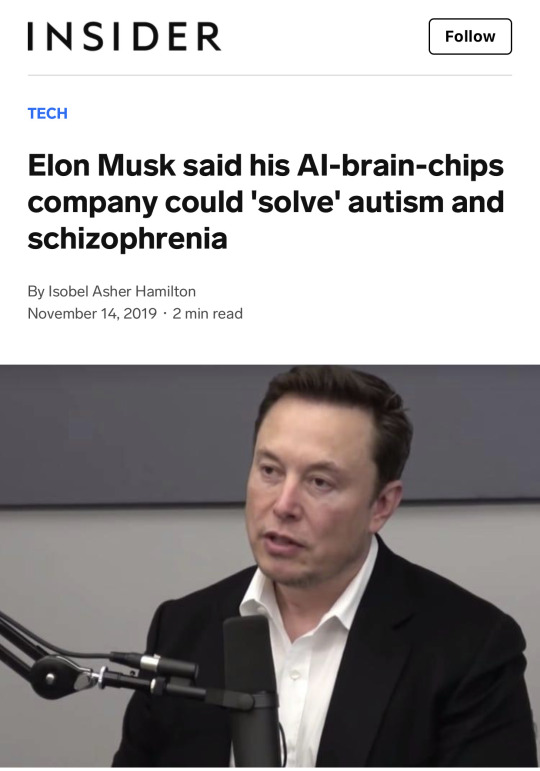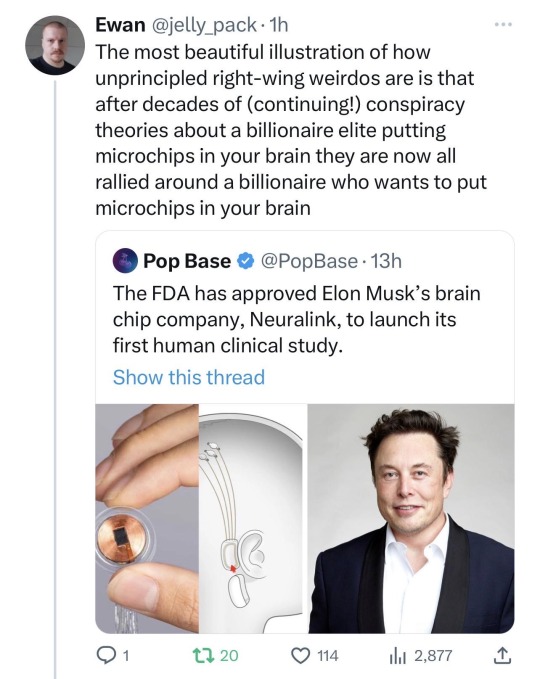#pcrm
Explore tagged Tumblr posts
Text
2024: Creating Change That Saves Animals and People by Physicians Committee on Youtube
5 notes
·
View notes
Text
الأنظمة النباتية تخفض جرعات الأنسولين وتحسن صحة مرضى السكر
تغيير بسيط في النظام الغذائي يحقق نتائج كبيرة لمرضى السكر بالنسبة للأشخاص المصابين بداء السكري من النوع الأول، يُعدّ التحول من المنتجات الحيوانية إلى الأطعمة النباتية استراتيجية فعالة لفقدان الوزن. على الرغم من أن البدائل النباتية للمنتجات الحيوانية غالبًا ما تُصنّف على أنها غير صحية بسبب كونها فائقة المعالجة، فإن العديد من الأطعمة النباتية يمكن أن تساهم في تحقيق نتائج صحية إيجابية. في مارس 2024،…
#GLP-1#PCRM#فقدان الوزن#لسان أوزمبي#منتجات الألبان#مؤشر النظام الغذائي النباتي#أطعمة نباتية#إنقاص الوزن#النظام الغذائي النباتي#التغذية العلاجية#الحميات الغذائية#الحمية النباتية#السمنة#الصحة العامة#الغذاء الصحي#بدائل اللحوم#حساسية الأنسولين#داء السكري من النوع الأول
0 notes
Text
Three AI insights for hard-charging, future-oriented smartypantses

MERE HOURS REMAIN for the Kickstarter for the audiobook for The Bezzle, the sequel to Red Team Blues, narrated by @wilwheaton! You can pre-order the audiobook and ebook, DRM free, as well as the hardcover, signed or unsigned. There’s also bundles with Red Team Blues in ebook, audio or paperback.

Living in the age of AI hype makes demands on all of us to come up with smartypants prognostications about how AI is about to change everything forever, and wow, it's pretty amazing, huh?
AI pitchmen don't make it easy. They like to pile on the cognitive dissonance and demand that we all somehow resolve it. This is a thing cult leaders do, too – tell blatant and obvious lies to their followers. When a cult follower repeats the lie to others, they are demonstrating their loyalty, both to the leader and to themselves.
Over and over, the claims of AI pitchmen turn out to be blatant lies. This has been the case since at least the age of the Mechanical Turk, the 18th chess-playing automaton that was actually just a chess player crammed into the base of an elaborate puppet that was exhibited as an autonomous, intelligent robot.
The most prominent Mechanical Turk huckster is Elon Musk, who habitually, blatantly and repeatedly lies about AI. He's been promising "full self driving" Telsas in "one to two years" for more than a decade. Periodically, he'll "demonstrate" a car that's in full-self driving mode – which then turns out to be canned, recorded demo:
https://www.reuters.com/technology/tesla-video-promoting-self-driving-was-staged-engineer-testifies-2023-01-17/
Musk even trotted an autonomous, humanoid robot on-stage at an investor presentation, failing to mention that this mechanical marvel was just a person in a robot suit:
https://www.siliconrepublic.com/machines/elon-musk-tesla-robot-optimus-ai
Now, Musk has announced that his junk-science neural interface company, Neuralink, has made the leap to implanting neural interface chips in a human brain. As Joan Westenberg writes, the press have repeated this claim as presumptively true, despite its wild implausibility:
https://joanwestenberg.com/blog/elon-musk-lies
Neuralink, after all, is a company notorious for mutilating primates in pursuit of showy, meaningless demos:
https://www.wired.com/story/elon-musk-pcrm-neuralink-monkey-deaths/
I'm perfectly willing to believe that Musk would risk someone else's life to help him with this nonsense, because he doesn't see other people as real and deserving of compassion or empathy. But he's also profoundly lazy and is accustomed to a world that unquestioningly swallows his most outlandish pronouncements, so Occam's Razor dictates that the most likely explanation here is that he just made it up.
The odds that there's a human being beta-testing Musk's neural interface with the only brain they will ever have aren't zero. But I give it the same odds as the Raelians' claim to have cloned a human being:
https://edition.cnn.com/2003/ALLPOLITICS/01/03/cf.opinion.rael/
The human-in-a-robot-suit gambit is everywhere in AI hype. Cruise, GM's disgraced "robot taxi" company, had 1.5 remote operators for every one of the cars on the road. They used AI to replace a single, low-waged driver with 1.5 high-waged, specialized technicians. Truly, it was a marvel.
Globalization is key to maintaining the guy-in-a-robot-suit phenomenon. Globalization gives AI pitchmen access to millions of low-waged workers who can pretend to be software programs, allowing us to pretend to have transcended the capitalism's exploitation trap. This is also a very old pattern – just a couple decades after the Mechanical Turk toured Europe, Thomas Jefferson returned from the continent with the dumbwaiter. Jefferson refined and installed these marvels, announcing to his dinner guests that they allowed him to replace his "servants" (that is, his slaves). Dumbwaiters don't replace slaves, of course – they just keep them out of sight:
https://www.stuartmcmillen.com/blog/behind-the-dumbwaiter/
So much AI turns out to be low-waged people in a call center in the Global South pretending to be robots that Indian techies have a joke about it: "AI stands for 'absent Indian'":
https://pluralistic.net/2024/01/29/pay-no-attention/#to-the-little-man-behind-the-curtain
A reader wrote to me this week. They're a multi-decade veteran of Amazon who had a fascinating tale about the launch of Amazon Go, the "fully automated" Amazon retail outlets that let you wander around, pick up goods and walk out again, while AI-enabled cameras totted up the goods in your basket and charged your card for them.
According to this reader, the AI cameras didn't work any better than Tesla's full-self driving mode, and had to be backstopped by a minimum of three camera operators in an Indian call center, "so that there could be a quorum system for deciding on a customer's activity – three autopilots good, two autopilots bad."
Amazon got a ton of press from the launch of the Amazon Go stores. A lot of it was very favorable, of course: Mister Market is insatiably horny for firing human beings and replacing them with robots, so any announcement that you've got a human-replacing robot is a surefire way to make Line Go Up. But there was also plenty of critical press about this – pieces that took Amazon to task for replacing human beings with robots.
What was missing from the criticism? Articles that said that Amazon was probably lying about its robots, that it had replaced low-waged clerks in the USA with even-lower-waged camera-jockeys in India.
Which is a shame, because that criticism would have hit Amazon where it hurts, right there in the ole Line Go Up. Amazon's stock price boost off the back of the Amazon Go announcements represented the market's bet that Amazon would evert out of cyberspace and fill all of our physical retail corridors with monopolistic robot stores, moated with IP that prevented other retailers from similarly slashing their wage bills. That unbridgeable moat would guarantee Amazon generations of monopoly rents, which it would share with any shareholders who piled into the stock at that moment.
See the difference? Criticize Amazon for its devastatingly effective automation and you help Amazon sell stock to suckers, which makes Amazon executives richer. Criticize Amazon for lying about its automation, and you clobber the personal net worth of the executives who spun up this lie, because their portfolios are full of Amazon stock:
https://sts-news.medium.com/youre-doing-it-wrong-notes-on-criticism-and-technology-hype-18b08b4307e5
Amazon Go didn't go. The hundreds of Amazon Go stores we were promised never materialized. There's an embarrassing rump of 25 of these things still around, which will doubtless be quietly shuttered in the years to come. But Amazon Go wasn't a failure. It allowed its architects to pocket massive capital gains on the way to building generational wealth and establishing a new permanent aristocracy of habitual bullshitters dressed up as high-tech wizards.
"Wizard" is the right word for it. The high-tech sector pretends to be science fiction, but it's usually fantasy. For a generation, America's largest tech firms peddled the dream of imminently establishing colonies on distant worlds or even traveling to other solar systems, something that is still so far in our future that it might well never come to pass:
https://pluralistic.net/2024/01/09/astrobezzle/#send-robots-instead
During the Space Age, we got the same kind of performative bullshit. On The Well David Gans mentioned hearing a promo on SiriusXM for a radio show with "the first AI co-host." To this, Craig L Maudlin replied, "Reminds me of fins on automobiles."
Yup, that's exactly it. An AI radio co-host is to artificial intelligence as a Cadillac Eldorado Biaritz tail-fin is to interstellar rocketry.


Back the Kickstarter for the audiobook of The Bezzle here!

If you’d like an essay-formatted version of this post to read or share, here’s a link to it on pluralistic.net, my surveillance-free, ad-free, tracker-free blog:
https://pluralistic.net/2024/01/31/neural-interface-beta-tester/#tailfins
#pluralistic#elon musk#neuralink#potemkin ai#neural interface beta-tester#full self driving#mechanical turks#ai#amazon#amazon go#clm#joan westenberg
1K notes
·
View notes
Text
> GEIOKY. -🍐
> Ghcd wh. Ghcd. Dzsogs. W qob vsof mci xigh DZSOGS ghcd. - ❤️
> MCI RC VSOF AS HVSB? HVSB RC GCASHVWBU. CDSB HVS RCCF PSTCFS MCI BC ZCBUSF QOB. - 🍐
> Mci ybck W qob'h cdsb wh. Mci ybck kvm W qob'h. - ❤️
> RC MCI KOBH AS HC CDSB WH? - 🍐
> Mci ybck kvoh kwzz voddsb wt mci rc. W'a vczrwbu mcif zwts wb am vobr. - ❤️
> Mci gvcizr hfsoh mcif pcrm zwys hvs acfhoz gciz wh wg. W qob ywzz mci kvsb W kobh hc. - ❤️
> W KWZZ FSHIFB OBMKOM. W KCIZR DFSTSF HC RWS CIHGWRS HVWG HWAS. - 🍐
> ..I'm sorry old friend. - ❤️
2 notes
·
View notes
Text

Soy yogurt, blueberries, and a ton of cinnamon!
New studies shared by the PCRM suggests that just 1tsp of cinnamon can boost metabolism by as much as 15% from your resting rate, on average 5-7% 💚
6 notes
·
View notes
Text
fun fact! ‘Subject 15’ (Gibbens, 2022), in which a monkey who was part of the Neuralink trials was found to tremble in fear when she saw staff, her conditioning becoming worse over many months until she had to be euthanized. Her necropsy found multiple hemorrhagic strokes and her cerebral cortex - the part of your brain that makes you you (Cleveland Clinic, 2022) - “focally tattered” (Gibbens, 2022).
This man is fucking awful.
Cleveland Clinic. (2022, May 23). Cerebral Cortex. Cleveland Clinic. https://my.clevelandclinic.org/health/articles/23073-cerebral-cortex
Gibbens, R. (2022). Violations of the Animal Welfare Act at University of California, Davis (93-R-0433) and Neuralink (93-R-0586) (pp. 1–6). https://pcrm.widen.net/s/7tqn59fhm8/2022-02-10-pcrm-usda-complaint-re-uc-davis-and-neuralink-with-exhibits-reduced

Oh so he’s doing eugenics now
157K notes
·
View notes
Text
Online Nutrition Program Offers Hope for Diabetes Management in India
A recent study suggests that a structured online nutrition program may help manage India’s growing diabetes crisis. Conducted by the Physicians Committee for Responsible Medicine (PCRM) and led by Dr. Vanita Rahman, an internal medicine physician, the research highlights how a plant-based diet can significantly improve the health of individuals with type 2 diabetes. Currently, over 101 million…
0 notes
Text
Vegan, um ato de amor, compaixão e sabedoria!

Em 2018, Centenas de médicos se reuniram em frente a casa branca nos EUA, com uma importante mensagem." Seja Vegano"!
A breve manifestação fez parte da programação da Conferência Internacional Sobre Nutrição em Medicina (Foto: Divulgação)Na última sexta-feira, o Comitê Médico Pela Medicina Responsável dos Estados Unidos (PCRM), uma organização sem fins lucrativos que tem o apoio de mais de 12 mil médicos, se reuniu em frente à Casa Branca, em Washington, para promover o veganismo. Além da clássica faixa “Go Vegan!”, motivando as pessoas a aderirem ao veganismo, o comitê presidido pelo médico Neal Barnard afirmou que “o futuro é vegano”.
No início do mês, o comitê médico anunciou que vai viajar pelo mundo ministrando seminários sobre a alimentação vegetariana, começando pela Índia. Uma das prioridades é ensinar sobre as propriedades preventivas e curativas de uma dieta vegetariana no combate à obesidade, doenças cardíacas e diabetes. Outro objetivo é diminuir o preconceito e a desinformação sobre o impacto da nutrição isenta de alimentos e ingredientes de origem animal.
A atitude compassiva torna o coração puro em todos os sentidos!

O primeiro hospital vegano do mundo. Hospital Hayek.
Ser vegano não é só comer salada como você pode pensar é comer o que você já come com exceção ao que seja de origem animal.
“Um nível relevante da sua paz provém da paz que você proporciona a outros seres vivos.”
1 note
·
View note
Quote
IARCによれば肉は食べてはならず、PCRMによればチーズはダメで、心臓専門医のWilliam Davisによれば穀物は食べられず、環境ワーキンググループ(EWG)によれば慣行栽培された野菜や果物は食べられず、小児内分泌学者のRobert Lustigによれば砂糖は毒である。つまり私たちは爪を噛むしかない、但し内分泌かく乱作用のあるフタル酸エステルを含むマニキュアを塗っていない場合だけ。
2024-10-15 - 野良猫 食情報研究所
1 note
·
View note
Text
wiki:
"....Experiments conducted by Neuralink and UC Davis have involved at least 23 monkeys, and the PCRM believes that 15 of those monkeys died or were euthanized as a result of the experiments. Furthermore, the PCRM alleged that UC Davis withheld photographic and video evidence of the mistreatment.[47]...
"A September 2023 exposé by Wired provided additional details on the primate deaths based on public records and confidential interviews with a former Neuralink employee and a current researcher at the California National Primate Research Center.[13][52] Those records showed complications with the installation of electrodes....
"In October 2023, Wired reported that Neuralink worked to keep details of animal suffering and death hidden from the public.[55]
"In November 2023, U.S. lawmakers asked the Securities and Exchange Commission to investigate whether Neuralink deceived investors in by omitting details about possible animal deaths.[56] ...
"[62][63][64]MIT Technology Review accused the demonstration of having the main objective to "stir excitement", adding that "Neuralink has provided no evidence that it can (or has even tried to) treat depression, insomnia, or a dozen other diseases that Musk mentioned in a slide".[62] Andrew Jackson, professor of neural interfaces at Newcastle University, also commented on the presentation to the BBC. To Musk's statement that he found Neuralink's advancements to be "profound", Jackson responded, "I don't think there was anything revolutionary in the presentation...
Thiago Arzua of the Medical College of Wisconsin argued that Neuralink's functions are not novel and that ideas for a brain–machine interface (BMI) are at least 50 years old.[66] He cited successful control of a robotic prosthetic arm by a man that gave him haptic feedback, which he used in 2016 to give President Obama a fist bump.[67] Arzua said that the 2020 Neuralink presentation "showed little more than a flashy new design for a BMI with more electrodes".[66] "
another grifter at work -nothing new keep reading the news
"BREAKING NEWS:" is dated May 2023 - too old


Not a single monkey survived the Neuralink experiment. I’ll bet Elmo can’t wait to start torturing and murdering human beings with this.
87K notes
·
View notes
Text
Did you read those articles? They both primarily cite the PCRM for their claims. These aren't "legit sources" if they all come from the same tainted primary source.
If you had already had "deranged horror villain experiments with the brains of live primates" on your Elon Musk corporate scandal bingo card, you're a pretty interesting person I gotta say
4K notes
·
View notes
Text
Neuigkeiten vom Sandu - Strich in Moldawien
PCRM-Neuigkeiten. MENSCHEN FLIEHEN AUS DEM LAND: DIE ZAHL DER EINWOHNER IN MOLDAWIEN SCHMILZT TÄGLICH – NUR DIE MITGLIEDER DER PASS GAN HABEN HIER EINE ZUKUNFT Die Bevölkerung Moldawiens ist rückläufig. Die Daten des National Bureau of Statistics der letzten Jahre spiegeln eine tragische Situation für das Land wider: Die Sterblichkeit übersteigt die Geburtenrate. Die Migration nimmt zu. Jedes…

View On WordPress
0 notes
Text
United States 🇺🇸 Ignores Elon Musk’s Dead Monkeys
Image promo from 12 Monkeys movie. Another day, another startup raises millions of dollars ($43 million specifically). But the real story is what is typed underneath glitz & glamor. In 2022, the Physicians Committee for Responsible Medicine (PCRM) alleged that Neuralink and UC Davis, once its research partner, had mistreated several monkeys involved with testing Neuralink hardware — subjecting…

View On WordPress
0 notes
Text
The Gruesome Story of How Neuralink’s Monkeys Died
https://www.wired.com/story/elon-musk-pcrm-neuralink-monkey-deaths/
1 note
·
View note
Text
Get empowered by food! PCRM is launching an 8-week online class series that starts 5/25 and it's totally free! You'll learn from docs how a plant based diet can help you lose weight, control blood sugar, lower blood pressure and more. Sign up here.
Class itinerary (subject to change):
Introduction to Empowered by Food
Foods for Better Blood Pressure, Blood Sugar, and Weight
Meal Planning With Success
Grocery Shopping on a Budget
Meal Prepping Like a Champion
Getting Healthy as a Household of One or More
Navigating Restaurant Carryout and Fast-Food Choices
Making Healthful Habits Your Lifestyle
13 notes
·
View notes
